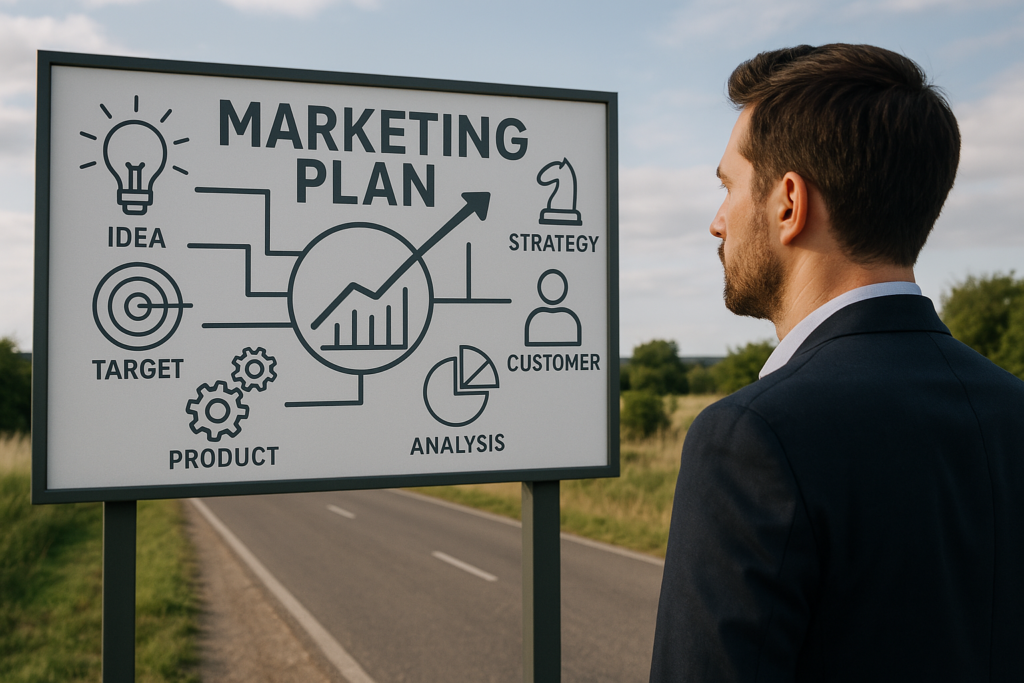Most marketing campaigns fail. Companies invest in paid ads, email campaigns, and content marketing but don’t see the expected return. The issue? They aren’t reaching the right target audience or using the right strategy for today’s digital landscape.
Consumers are flooded with content across social media channels, search engines, and other brands. Standing out requires a successful marketing strategy that prioritizes data-driven insights, automation, and personalization. Businesses that fail to evolve will struggle to generate revenue, increase sales, and achieve their business objectives.
In 2025, technology companies and smaller companies alike need to rethink their marketing plan by using strategic technology, inbound marketing, and thought leadership to build brand awareness and engage potential customers.
This guide outlines 10 must-know marketing strategies designed to help businesses effectively communicate, establish credibility, and reach new audiences. By following these strategies, companies can create a comprehensive plan to stay competitive and thrive in a fast-changing digital world.
1. AI & Automation: Smarter, Not Harder
Marketing without AI is like running a marathon in heavy boots. Businesses relying on outdated marketing efforts struggle to keep up in today’s fast-changing digital world. AI isn’t replacing marketing teams—it’s making them smarter, faster, and more effective.

AI tools now process customer data, refine SEO strategy, and adjust paid ads in real time, allowing businesses to:
- Improve lead generation – AI-driven insights help target the ideal customer and deliver the right message.
- Enhance customer experience – Automated responses and personalized recommendations keep potential customers engaged.
- Optimize content marketing – AI predicts what topics will attract the target market and drive organic traffic.
For example, AI-powered chatbots help technology companies automate customer support, while strategic technology tools adjust advertising bids based on market research. Tech companies that embrace AI will increase sales, reduce wasted spending, and improve conversion rates, while those that don’t will struggle to remain competitive.
2. SEO in 2025: Competing with AI & Voice Search
Most businesses focus on ranking higher in search engines. What they don’t realize is that AI is changing the way search works. AI-generated responses, voice search, and zero-click results are making traditional SEO strategies less effective.
To stay visible in 2025, businesses need to:
- Optimize for voice search – People speak differently than they type. Adapting content to natural speech patterns helps businesses reach potential customers.
- Structure content for AI-driven search – AI scans pages for direct answers, so clarity and helpful content are essential.
- Balance paid and organic strategies – SEO alone won’t drive growth anymore. A mix of SEO strategy, content marketing, and paid ads is necessary.
Successful technology companies and tech companies are already using AI-powered tools to refine their marketing plan and dominate search rankings. Businesses that don’t evolve will struggle to reach customers and lose traffic to competitors.
3. Building Brand Authority with Content Marketing
Most companies create content, but few build real authority in their industry. Consumers are overwhelmed with information, and generic content no longer works. To stand out, businesses need a content marketing strategy that delivers value and credibility.
In 2025, the most effective marketing strategies will focus on:
- Long-form, high-value content – In-depth guides, case studies, and how-to videos that establish thought leadership.
- User-generated content – Encouraging the target audience to share their experiences builds trust faster than any ad.
- Interactive content – Quizzes, personalized recommendations, and videos that engage potential customers.
Companies that prioritize content marketing will build brand awareness, establish credibility, and increase sales. Those that fail to create helpful content will struggle to effectively communicate with their audience and fall behind.
4. Maximizing Marketing Budgets for Higher ROI

Marketing isn’t about how much you spend—it’s about how wisely you invest. Many companies pour money into paid ads, email campaigns, and social media accounts without a clear plan, leading to wasted budgets and low conversion rates.
To maximize ROI, businesses should:
- Use data to guide spending – AI-driven insights help marketing teams allocate resources efficiently.
- Focus on high-ROI channels – A mix of SEO strategy, inbound marketing, and social media channels creates sustainable growth.
- Balance organic and paid efforts – Paid ads generate quick traffic, but content marketing builds long-term visibility.
According to The Australian, the Australian Government increased its marketing budget by one-third in the 2023-24 financial year, spending $174 million on advertising (Source). This reflects a global trend—companies must optimize their marketing efforts for measurable impact.
Businesses that track customer data, market research, and conversion rates will generate revenue and achieve their business goals without overspending.
5. The Social Media & Influencer Revolution
Many brands treat social media as just a place to post content. In 2025, social media isn’t just for engagement—it’s a major driver of sales, brand awareness, and lead generation. Businesses that fail to optimize their social media channels will lose potential customers to competitors who do.
Winning strategies include:
- Leveraging strategic technology – AI-driven tools analyze customer data to improve targeting and effectively communicate with audiences.
- Building brand credibility through influencer partnerships – Niche influencers offer higher trust, better audience alignment, and stronger conversion rates than mega-celebrities.
- Monetizing social media accounts – Features like live shopping, interactive ads, and in-app purchases allow brands to generate revenue directly on platforms.
- Expanding across multiple platforms – A strong presence across various social media accounts ensures brands reach customers where they spend the most time.
The brands that create content tailored to their target market, integrate user-generated content, and use thought leadership to establish authority will see higher engagement, increased sales, and stronger customer relationships.
6. Sustainable and Ethical Marketing Practices
Marketing without ethics is a risk no brand can afford. Consumers are more informed than ever, and they expect businesses to act responsibly. Brands that ignore sustainability or misuse customer data risk losing trust—and once it’s gone, it’s hard to rebuild.
To stay ahead, companies must:
- Commit to real sustainability – Customers want proof, not empty promises. Brands must show measurable impact and transparency.
- Respect customer privacy – Personalization matters, but misusing data damages trust. Clear policies on customer journey protection are a must.
- Market with integrity – Honest messaging and ethical advertising aren’t just good practice—they’re expected.
- Use strategic technology for compliance – AI-driven tools help brands ensure their marketing efforts align with ethical standards.
The businesses that integrate sustainability and transparency into their marketing plan will establish credibility, engage customers, and build brand awareness in a way that resonates with modern consumers.
7. Future-Proofing Your Marketing Plan
Why Most Marketing Strategies Fail
Many businesses rely on the same marketing strategies year after year. But the reality is, consumer behavior, technology, and competition are constantly evolving. Companies that fail to adjust their marketing efforts risk falling behind as new trends and platforms emerge.

Investing in Continuous Learning
The best marketing teams don’t just react to trends—they anticipate them. Staying ahead requires:
- Tracking market research to predict shifts in customer behavior
- Testing new tools and strategic technology to improve efficiency
- Refining marketing plans based on data-driven insights
Businesses that commit to ongoing learning and adaptation will be better positioned to achieve long-term business objectives.
Leveraging Automation for Efficiency
Automation isn’t just about convenience—it’s about maximizing marketing budgets and improving conversion rates. AI-powered tools help companies:
- Analyze customer data to personalize marketing campaigns
- Automate email campaigns, paid ads, and customer interactions
- Improve efficiency, freeing teams to focus on business goals
By integrating AI and automation, businesses can engage customers more effectively and drive sustainable growth.
Diversifying Marketing Channels
Relying on a single platform is risky. A comprehensive plan should include:
- SEO strategy to drive organic traffic
- Content marketing to establish thought leadership
- Social media channels to expand reach and brand presence
- Paid ads for quick visibility and lead generation
A diversified marketing strategy ensures businesses remain visible even as search engines, customer behaviors, and digital platforms evolve.
Balancing Short-Term Wins with Long-Term Growth
Many brands focus on quick wins but overlook sustainable growth. While paid ads and promotions generate immediate sales, a future-proof strategy includes:
- Evaluating marketing performance on an annual basis
- Aligning campaigns with long-term business objectives
- Adjusting marketing plans based on emerging trends
The brands that adapt, innovate, and embrace technology marketing will achieve lasting success, while those resistant to change will struggle to reach customers and stay competitive.
8. Lead Generation & Customer Data
Why Traditional Lead Generation No Longer Works
Many businesses struggle with lead generation because they rely on outdated tactics. Cold emails, generic paid ads, and broad marketing campaigns fail to attract the ideal customer. Today’s buyers expect personalized experiences and only engage with brands that understand their needs.
Using Customer Data to Improve Targeting
Successful marketing strategies are built on data. AI and analytics help businesses:
- Identify patterns in customer journey behavior
- Segment audiences based on preferences and past interactions
- Deliver highly relevant offers through social media channels and email campaigns
By using customer data effectively, brands can increase sales, improve conversion rates, and optimize marketing budgets.
Balancing Automation and Personalization
Automation helps brands scale, but over-reliance on AI-driven communication can feel impersonal. The key is to:
- Use paid ads and AI to attract potential customers
- Personalize interactions through dynamic content and targeted messaging
- Ensure marketing efforts remain authentic while leveraging automation
Aligning Lead Generation with Business Goals
For lead generation to be effective, it must align with broader business objectives. High-quality leads come from:
- SEO strategy and content marketing to drive organic traffic
- Interactive tools like quizzes, how-to videos, and user-generated content
- A mix of paid ads, inbound marketing, and market research-driven campaigns
Businesses that optimize lead generation through customer data insights and automation will achieve higher engagement, better conversion rates, and sustained growth.
9. Balancing Paid & Organic Growth
The Challenge of Relying Only on Paid Ads
Many businesses depend heavily on paid ads to drive traffic and sales. While ads can generate immediate results, relying on them alone can be risky. Advertising costs are rising, competition is increasing, and consumers are becoming more resistant to promotional content. A well-rounded marketing plan must balance organic traffic and paid campaigns for sustainable growth.
Why Organic Growth is Needed
Organic marketing builds long-term brand visibility and trust. Businesses that invest in:
- SEO strategy to improve rankings on search engines
- Content marketing that provides helpful content and engages the target audience
- Social media channels to expand brand reach and encourage user-generated content
see a more consistent return on their marketing efforts. Organic growth strengthens brand authority, conversion rates, and customer loyalty without the constant cost of paid advertising.
Using Paid Ads Strategically
Paid campaigns are still essential, but they work best when used strategically:
- Retargeting past visitors to bring them back into the customer journey
- Running social media accounts and paid ads together for broader reach
- Using data-driven insights to refine ad targeting and reach customers more effectively
The Right Strategy for Sustainable Success
A comprehensive plan that integrates paid and organic strategies ensures brands don’t rely too much on one channel. The most successful marketing strategies combine thought leadership, SEO, inbound marketing, and paid campaigns to create sustained growth and increased sales.
10. Strategic Technology & Market Research

Why Data-Driven Decision-Making Matters
Many businesses fail because they make marketing decisions based on outdated methods instead of real-time insights. Without proper market research, companies risk wasting their marketing budget on ineffective campaigns. In 2025, success depends on technology-driven insights that refine marketing strategies and help businesses stay ahead of competitors.
Using AI and Data to Identify the Right Channels
Businesses must focus on data to make informed choices. AI-powered tools allow technology companies and smaller companies to:
- Analyze customer journey insights to improve conversion rates
- Identify pain points in marketing campaigns and adjust messaging
- Guide users through more personalized experiences using automation
By tracking search engine trends, social media accounts, and inbound marketing performance, companies can reach new audiences and improve engagement.
Leveraging Market Research for Competitive Advantage
Brands that rely on market research and strategic technology will gain a clearer understanding of their target market. AI-powered tools help with:
- Predicting consumer behavior to refine content marketing and paid ads
- Monitoring other brands to learn from successful strategies
- Optimizing email campaigns to improve customer retention
A Comprehensive Plan for Future Growth
A successful marketing strategy requires continuous tracking and refinement. Businesses that integrate SEO strategy, customer data analytics, and thought leadership into their marketing plan will be able to:
- Increase sales and generate revenue with smarter targeting
- Effectively communicate brand value to decision-makers and key staff
- Establish credibility and build brand awareness in competitive markets
By embracing technology marketing and data-driven insights, companies will stay ahead of industry shifts, engage customers, and achieve long-term business success.
Elevate Your Marketing Game in 2025
Marketing is more competitive than ever. Consumers have more choices, digital trends shift quickly, and businesses that don’t adapt risk falling behind. To stay ahead, brands need a comprehensive plan that combines technology marketing, customer insights, and data-driven decision-making.
Some businesses invest heavily in paid ads but fail to build organic traffic. Others rely too much on social media accounts without a clear marketing plan. The key to success in 2025 is balancing multiple strategies, leveraging market research, and using AI-driven insights to optimize performance.
Smart companies are already adopting SEO strategy, inbound marketing, and strategic technology to enhance their marketing efforts. The right approach allows brands to engage customers, establish credibility, and generate revenue while keeping costs under control.
A strong digital marketing strategy requires the right expertise, tools, and execution. Businesses that invest in content marketing, email campaigns, and thought leadership will see stronger conversion rates and sustainable growth.
Ready to implement the most effective ways to grow your brand? Get started today with Appsecute and take your marketing to the next level.
